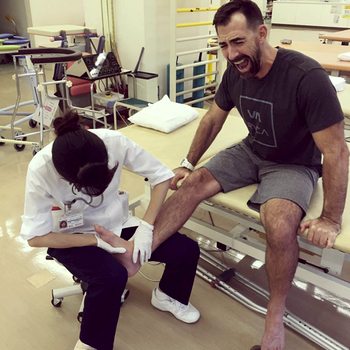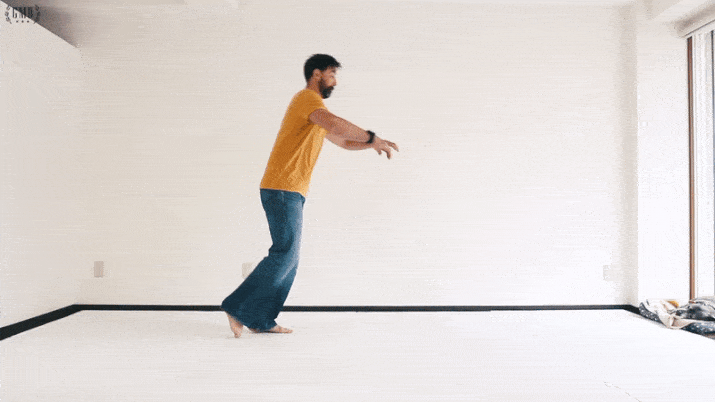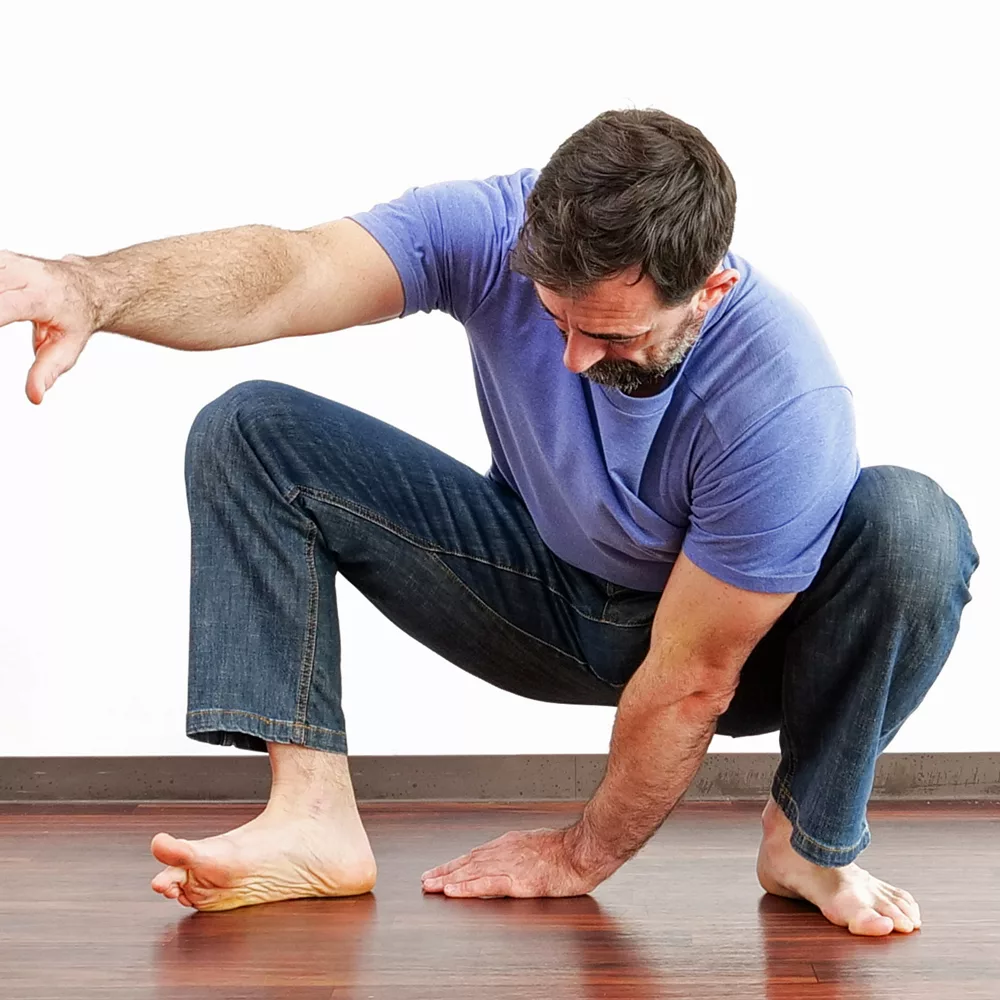Contents: Why You Need to Know How to Fall / Falling Technique Video / Additional Agility Resources/ Kickstart Your Training
 I fell while skateboarding in August 2016, and broke my ankle in 3 places.
I fell while skateboarding in August 2016, and broke my ankle in 3 places.
Shit happens. Yes, even to those of us who’ve been training for 40 years and “should” (whatever that means) know better. Literally everyone will fall at some point, so it’s a good idea to know what to do when the unexpected happens to you—because it will.
In this article, I’m going to give you some concrete techniques to practice so that you’re well prepared to fall as safely as possible if and when that happens.
Let’s get into it.
Why Everyone Needs to Know How to Fall
Let me start by addressing the elephant in the room. You may be wondering why you should bother spending time learning how to fall, if I got hurt in an unexpected fall even after 40 years of training.
And the answer is simple. Without all that training and conditioning, I would have gotten hurt way worse than I did, and my recovery would have been a whole lot slower. A year after my accident, I was 100% back to my previous “glory,” so to speak, and that never would have been possible without all my previous conditioning.
It really doesn’t matter how much or how little conditioning you have. It doesn’t matter how old or young you are. And, honestly, it doesn’t matter what your specific training goals are. Everyone will be better protected from injury if they are well acquainted with proper falling technique.
What are the Risks of Not Knowing How to Fall?
The obvious risk is “injury,” but let’s get a little more specific than that.
According to the Center for Disease Control (CDC), injuries from falls are responsible for over 800,000 hospitalizations each year. Most of these are head injuries or hip fractures, both of which are highly correlated with mortality in the elderly.
Now, you may be thinking that this doesn’t apply to you if you’re under the age of 65—why should you be worrying about hip fractures in the elderly?
Two reasons:
- Hip fractures are one of the most painful and deadly injuries in the elderly. Trust me, you don’t want to be dealing with that at any age. And the only way you’re going to minimize your risks of injuries like that when you’re older is by protecting yourself when you’re younger.
- As you can learn from my experience, you can get injured from a fall at any age, so don’t think you’re safe just because you’re young and fit, or if you don’t do “dangerous” activities. Conditioning yourself now can save you from a very serious injury down the line.
And again, in my case, if I had not been well conditioned to know how to fall safely, I have no doubt my injury would have been far worse, or I would have come away with more than just a broken ankle.
Once again for those in the back: this is important, people!
So let’s go over some key techniques for learning how to fall safely so you’re well prepared for whatever happens in your life.
Techniques for Falling Without Hurting Yourself
Of course, no matter how well prepared you are, when the unexpected happens, there’s no guarantee you won’t get hurt. But arming yourself with proper techniques, and conditioning your body to instinctually go into protective positioning, can make all the difference in whether you walk away from a tumble unscathed (or with a lesser injury), or badly injured.
In the video above, you’ll see details on the following techniques:
1. Falling Backward
Knowing how to fall backward is important, since it happens quite often. If you slip as you’re going downstairs, you’re going to fall backward, and if you don’t know how to protect yourself, you could get seriously injured. Here are some principles that will keep you safe:
- Whatever position you’re falling from, you’ll want to practice squatting down as low as you can, as soon as you feel yourself falling backward.
- Tuck your chin in to your chest and round your back to absorb the impact.
- Finally, extend your arms out to the sides, hitting the ground with your arms extended, then quickly letting them pop off the ground.
The last thing you want to do is fall onto your wrist, or onto the back of your head. Getting yourself used to these three instinctive responses is important for keeping you safe if and when a fall ever happens.
2. Falling Forward
Faceplanting: The #1 most embarrassing result of tripping over a garden hose at your friend’s BBQ. Knowing how to react to something like that happening can mean the difference between your friends making fun of you forever (along with possibly breaking your nose), and walking away with your body and reputation unscathed.
Here are some key points for falling forward safely:
- Keep your elbows bent to a 90-degree angle, with the palms open in front of your face. When you fall forward, you’ll land on your forearms with your wrists neutral (make sure not to bend the wrists or you could break them). This will protect your face from hitting the ground.
- Make sure to also keep from landing on your elbows—that would hurt like crazy!
- Practice this falling forward motion on a soft surface in the beginning, gradually working your way to harder surfaces so that you’re prepared for (just about) anything.
This particular technique can be really scary at first, but once you’re comfortable with it, it can be a lifesaver.
3. Falling Sideways
Of course, falls often happen in the most awkward positions, and you’re likely not going to fall straight forward or straight backward. But if you fall to the side (in whatever manner), the principles of falling forward and backward still apply. It just depends on the angle at which you fall.
- In many cases, you’ll use the same technique as falling backward, just with one hand extended, sometimes with the same side leg extended too (this often happens if you slip on one side).
- If your body is a bit more turned, it may make more sense to continue that rotation and fall as though you were falling forward, landing on your forearms.
It’s important to practice these falls in a safe and controlled manner, but making sure you work on different angles and levels so that you get used to immediately going into protective postures.
More Resources for Building Agility
Knowing how to fall safely is an essential piece of protecting yourself against injury when shit happens. It’s part of building overall agility, which allows you to move through your life and physical activities with ease and confidence.

But there are many other pieces of agility, and working on improving all of these different areas will help your body respond better to unpredictable circumstances (and, let’s face it—how much of life is really predictable?). These additional resources will help you build the various attributes you need for overall agility.
- Improve Your Body Control—Probably the most important part of building agility is improving your overall body control. If you don’t have good control over your movements, you’ll have a tough time responding appropriately to unexpected circumstances.
- Become Less Clumsy—If you’re on the clumsy side, you’re probably already pretty accident-prone, and these techniques for falling safely will come in handy! But there are some other things you can do to make yourself a little less clumsy in general.
- Get Comfortable with Transitional Movements—Unexpected accidents tend to happen in the “in-between,” when we’re moving between positions. This article and video will show you how to build control over those transitions.
- Learn How to Tumble—If you enjoyed learning the techniques shown above for falling safely, you might also enjoy our tutorial on how to tumble. Many of the principles are similar, just with a different focus and emphasis. Either way, it’s a lot of fun 🙂
- Incorporate Play into Your Routine—One of our favorite ways to build agility and control is through play, and not just because it’s a lot of fun. It’s an essential part of learning how to manipulate your body in the ways you need to.
- Manage and Avoid Injuries—Last, but not least, it’s important to know what to do if and when an injury does happen.
Building a base of strength, flexibility, and control will prepare your body for whatever you need it to do for you—whether that’s running after the bus without pulling a hamstring, keeping up with your CrossFit buddies, or responding to unexpected falls in a way that keeps you from getting badly injured.
If you’re looking for something you can easily add into your current routine, check out Resilience:
Specific Training for a More Resilient Body
Our Resilience training program trains your joints and connective tissues to withstand force and impact for confident performance and reduced chances of injury.




